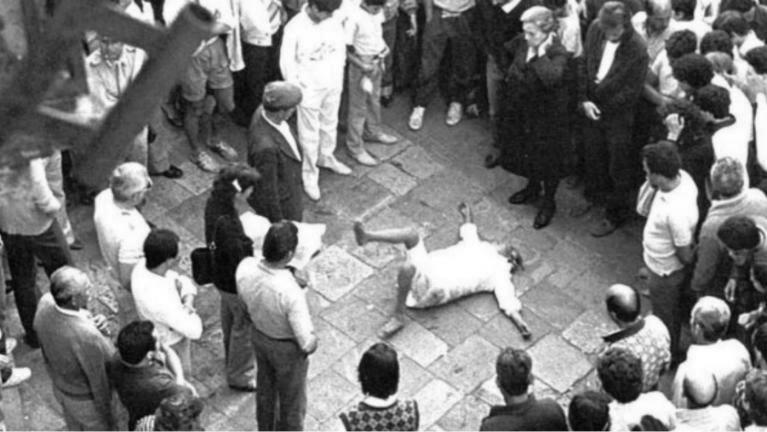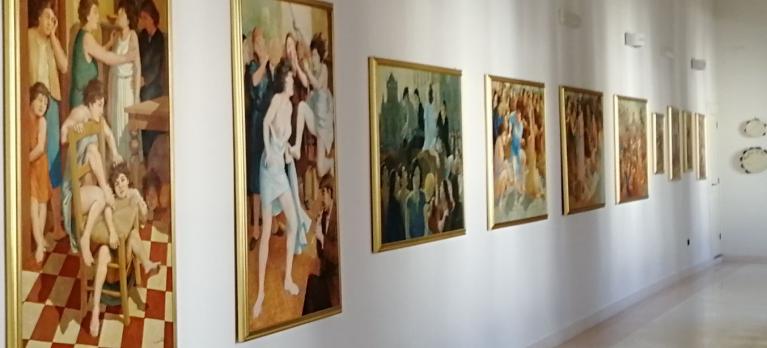

Historical re-enactment of the ancient therapeutic home ritual by: Club for UNESCO of Galatina
It is difficult not to have heard, at least once, of the "tarantata", women of the past, not too far away, who during the summer season, in the days of harvest, bent over on their knees, were "pinched" by the spider tarantula.
They have written men of science, anthropologists and ethnologists, they have researched the causes, described the gestures, interpreted the signs. Certainly it was established that no spider exists in Puglia capable of causing those symptoms; the causes of tarantism are to be found elsewhere. First of all, in the culture of a land, Puglia has always been a crossroads of peoples, of history, of a Mediterranean nature of its own, a land of sun and suffering, of ancient tribal rites and pagan symbols never forgotten. "Middle-earth" and like all lands of magical and sacred means.
De Martino Sud e Magia - De Martino La terra del Rimorso - Chiriatti Morso d'amore - Campbell Mitologia occidentale

24 giugno 1969 - Teche RAI - Antropologia e etnologia, Cultura, Società
Apulian tarantism, a phenomenon that encompasses almost all the main aspects of traditional magic rituals and the forms in which they survived, is the object of investigation of the Magia e Società radio cycle. Rites and survivals in the Italian popular tradition, edited by Girolamo Mancuso and Franco Scaglia.
ANALYSIS OF THE PHENOMENON
Tarantism (or tarantolism), beyond being considered simply a phenomenon of an isteroid nature, is interesting due to the complex socio-anthropological values underlying it.
The Demartinian research of 1959 has masterfully highlighted the functionality of this ritual within the culture of the popular classes of the Salento, framing it in the overall problem of the "southern question" that in those years was increasingly determining itself as central in a vast political debate -cultural.
Those affected by tarantism believe that their evil was caused by the bite of an animal which is usually called the "taranta" insect biologically known as Latrodectus Tredecim Guttatus.
However the various researches carried out on this phenomenon and the testimonies of the doctors of the area have amply demonstrated that only in very rare cases those who consider themselves affected by tarantism manifest the symptoms proper to latrodectism.
On the other hand, this is certainly not the only element that invalidates any attempt at a medical approach to the phenomenon and supports its cultural values. It will be sufficient here to recall the magical territorial immunity which the whole surrounding area has in Galatina (Lecce) where evil is treated, but is not manifested by virtue of the mythical protection of St. Paul.
The complex ritual of exorcising tarantism emphasizes pagan elements, typical of the ancient world, synchronously combined with the hegemonic Catholicism that over time has always tried to incorporate this phenomenon into its sphere.
The representation begins when the tarantato perceives the warning signs, mostly of a neurovegetative or psychic type (apparent obnubilation of the state of consciousness, emotional disorders, etc.).
He generally asks for music to be performed and then starts an incessant and exasperated dance that aims to diagnose the type of taranta that bit him ("libertine", "sad and mute", "stormy", etc.) .
Subsequently one passes to a phase of "chromatic exploration" in which the patient is attracted to garments, generally handkerchiefs, whose colors correspond to those of the taranta that would have bitten him.
Sometimes the attraction manifests itself with aggressive attitudes towards people who wear conspicuously colored clothes and which circle the patient.
In the third phase, dance, the symptoms of possession, epilettoid, depressive-melancholic or limited to a pseudo-stuporous state, occur in the tarantato.
The dance phase, or "bipartite choreutic cycle" as De Martino defined it, takes place with an alternation of expiatory attitudes - epileptiform convulsions or stereotyped postures accompanied by apparent loss of contact with the surrounding environment and liberators with pantomimes that simulate identification of the sick with the taranta.
The ritual ends with a symbolic trampling of the taranta that symbolizes the "liberation" of the sick and the success of the ritual of exorcism.
Galatina (Lecce) June 1980….
In this document the authors underline the disappearance, in recent years, of the ritual manifestations lived in the "collective" and the relegation of the phenomenon in the family environment.
In the decades following the demartinian research, there is a further process of disintegration of this phenomenon: in it the collective moments are gradually disappearing and less and less the tarantati who go to the little church of S on 28 and 29 June each year Paul to Galatina to give life to their healing ritual. Those who still undergo this practice - in 1980 they were just two - are no longer waiting, in the square of Galatina, for a peasant community that shares their own cultural horizon, but a curious and heterogeneous crowd from which they need to protect themselves.
On the wagon that in the past led the group of tarantati from the surrounding countryside to the therapeutic site, cars are replaced today from which the sick come down a few meters from the entrance of the church.
A relative carefully watches over the few minutes of the therapeutic ritual performed before the church and is ready to lash out against anyone who intends to photograph or film what is happening.
Thinking of entering the chapel to observe the ritual taking place inside is completely in vain: only one or two close relatives are given a similar concession.
The tarantati leave the church after just a few minutes and this testifies to a further phase of disintegration of the phenomenon. They now know that it is no longer permissible to transfer their individual crises to the collective and remain entangled in a dimension of cultural anomie in which they perceive that they can increasingly rely less on this form of traditional therapy.
Galatina - Museo Civico Pietro Cavoti - Tele di Luigi Caiuli - Galleria dedicata al Tarantismo
